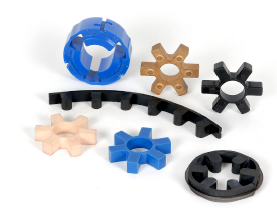Elastomers In Compression
We presents 4 styles of elastomer types to allow for added flexibility in addressing specific application necessities. One particular piece designs are utilized in the “L” and “AL” versions (referred to as spiders) and numerous portion “load cushions” are utilized in the “C” and “H” model couplings. The load cushions are in sets of six to 14 pieces according to coupling dimension.
Strong Center Spider
The strong center style and design is frequently made use of layout when shafts with the driver and driven equipment is often stored separate by a typical gap
Open Center Spider
The open center design allows to the shafts of your driver and driven to become positioned within a short distance
Open center spiders supply shaft positioning versatility but have a reduce RPM capacity
Cushions
Employed solely to  the C and H Kind couplings
the C and H Kind couplings
Load cushions are held in location radially by a steel collar and that is attached to one of many hubs
Snap Wrap Versatile Spider
Design and style allows for simple removal from the spider with out moving the hubs
Lets for shut shaft separation the many way as much as the hubs greatest bore
Greatest RPM is 1,750 RPM with the retaining ring, but if used with all the LC Style (with collar) the usual RPM rating in the coupling applies
Style is available in NBR and Urethane only, and in restricted sizes
Spider Materials
SOX (NBR) Rubber
The standard material which is highly flexible materials that is definitely oil resistant
Resembles all-natural rubber in resilience and elasticity, and operates efficiently in temperature ranges of -40° to 212° F (-40° to 100° C)
Urethane
Has one.5 occasions greater torque capability than NBR
Good resistance to oil and chemical substances
Material offers less dampening impact and operates at a temperature range of -30° to 160° F
Hytrel
Versatile elastomer developed for higher torque and large temperature operations
Operates in temperatures of -60° to 250° F (-51° to 121° C)
Bronze
Rigid, porous, oil-impregnated metal insert solely for lower speed (max 250 RPM) applications requiring higher torque capabilities
Not impacted by water, oil, filth, or extreme temperatures – operates in temperatures of -40° to 450° F (-40° to 232° C)